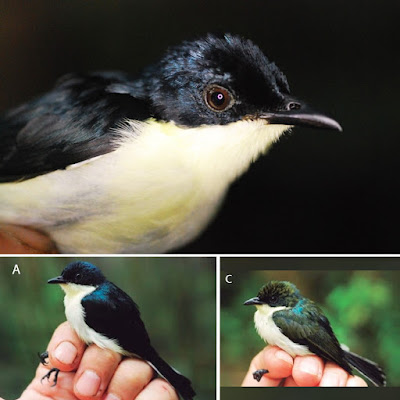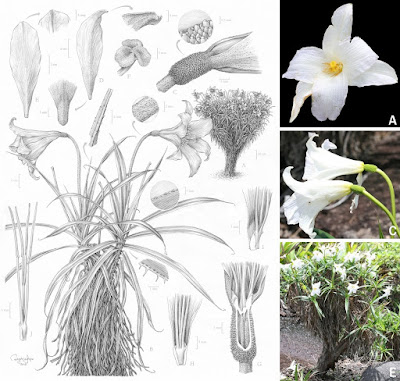[Most Recent Entries] [Calendar View]
Sunday, June 13th, 2021
| Time | Event | ||||
| 2:02a | [Ornithology • 2021] Melanocharis citreola • A New, Undescribed Species of Melanocharis Berrypecker from western New Guinea and the Evolutionary History of the Family Melanocharitidae (Passeriformes)
Abstract Western New Guinea remains one of the last biologically underexplored regions of the world, and much remains to be learned regarding the diversity and evolutionary history of its fauna and flora. During a recent ornithological expedition to the Kumawa Mountains in West Papua, we encountered an undescribed species of Melanocharis berrypecker (Melanocharitidae) in cloud forest at an elevation of 1200 m asl. Its main characteristics are iridescent blue-black upperparts, satin-white underparts washed lemon yellow, and white outer edges to the external rectrices. Initially thought to represent a close relative of the Mid-mountain Berrypecker Melanocharis longicauda based on elevation and plumage colour traits, a complete phylogenetic analysis of the genus based on full mitogenomes and genome-wide nuclear data revealed that the new species, which we name Satin Berrypecker Melanocharis citreola sp. nov., is in fact sister to the phenotypically dissimilar Streaked Berrypecker M. striativentris. Phylogenetic relationships within the family Melanocharitidae, including all presently recognized genera (Toxorhamphus, Oedistoma, Rhamphocharis and Melanocharis), reveal that this family endemic to the island of New Guinea diversified during the main uplift of New Guinea in the Middle and Late Miocene (14-6 Mya), and represents an evolutionary radiation with high disparity in bill morphology and signalling traits across species. Rhamphocharis berrypeckers fall within the Melanocharis clade despite their larger beaks, and should be included in the latter genus. Interspecific genetic distances in Melanocharis are pronounced (average interspecific distance: 8.8% in COI, 12.4% in ND2), suggesting a long history of independent evolution of all lineages corresponding to currently recognized species, including the Satin Berrypecker, which shares a most recent common ancestor with its sister species in the early Pleistocene (~2.0 Mya). Keywords: Endemism, Expedition, Island, Passerides, Speciation, West Papua
Melanocharis citreola, sp. nov. Milá, Ashari & Thébaud Satin Berrypecker, Burungbuah Satin, Diagnosis. – The new species can be readily assigned to Melanocharis by the stout black bill and iridescent blue-black upper parts contrasting with lighter underparts. It can be distinguished from all other members of the genus by the satin-white underparts, washed lemon yellow. It has a white outer vane of the outermost rectrix, compared to the two outermost rectrices in M. longicauda, which is also smaller and has yellowish-grey underparts. M. versteri has a longer tail with more extensive white patches on several external rectrices, and grey underparts. Etymology. – Melanocharis Sclater 1858 means black beauty. The specific epithet citreola refers to the lemon-yellow wash on the satiny-white underparts of males. The vernacular names Satin Berrypecker, Burungbuah Satin, Picabayas Satinado and Piquebaie Satiné, in English, Indonesian, Spanish and French, respectively, highlight the most striking characteristic of the new species. Borja Milá, Jade Bruxaux, Guillermo Friis, Katerina Sam, Hidayat Ashari and Christophe Thébaud. 2021. A New, Undescribed Species of Melanocharis Berrypecker from western New Guinea and the Evolutionary History of the Family Melanocharitidae. Ibis. DOI: 10.1111/ibi.12981 | ||||
| 2:57a | [Botany • 2021] Vellozia inselbergae (Velloziaceae) • A New Species from the Brazilian Atlantic Forest Inselbergs
Abstract Vellozia inselbergae Mello-Silva ex Andr.Cabral, a new species of Velloziaceae endemic to the Atlantic Forest inselbergs in the Brazilian state of Bahia, is here described. The new species is morphologically similar to Vellozia armata and Vellozia luteola, putatively belonging to the same clade, but is distinguished from them mainly by the longer pedicel, cylindrical-ellipsoid hypanthium, white and larger tepals, stamen number, longer anthers and style, and larger capsules. Detailed morphological and anatomical descriptions, illustration and photographic plates, distribution map, and conservation status of Vellozia inselbergae are provided. Keywords: Monocots, Bahia, Pandanales, rocky outcrops, taxonomy Vellozia inselbergae Mello-Silva ex Andr.Cabral, sp. nov. Etymology:—The specific epithet refers to the Atlantic Forest inselbergs located in the Bahia state, where the new species is endemic. Andressa Cabral, Renato Albuquerque Magri and Jenifer de Carvalho Lopes. 2021. Vellozia inselbergae (Velloziaceae), A New Species from the Brazilian Atlantic Forest Inselbergs. Phytotaxa. 497(2); 138–146. DOI: 10.11646/phytotaxa.497.2.6 |
| << Previous Day |
2021/06/13 [Calendar] |
Next Day >> |












